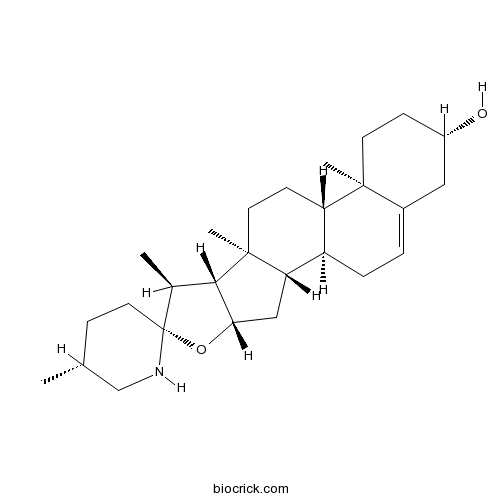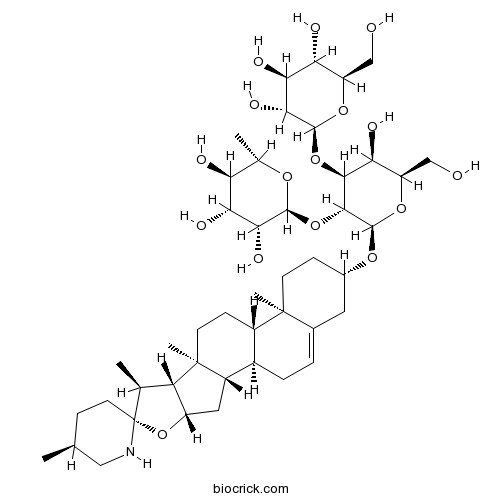Solanum muricatum
Solanum muricatum
1. The products in our compound library are selected from thousands of unique natural products; 2. It has the characteristics of diverse structure, diverse sources and wide coverage of activities; 3. Provide information on the activity of products from major journals, patents and research reports around the world, providing theoretical direction and research basis for further research and screening; 4. Free combination according to the type, source, target and disease of natural product; 5. The compound powder is placed in a covered tube and then discharged into a 10 x 10 cryostat; 6. Transport in ice pack or dry ice pack. Please store it at -20 °C as soon as possible after receiving the product, and use it as soon as possible after opening.
Natural products/compounds from Solanum muricatum
- Cat.No. Product Name CAS Number COA
-
BCN2346
Solasodine126-17-0
Instructions

-
BCN2302
Solasonine19121-58-5
Instructions

Phytotoxicity and cytogenotoxicity of hydroalcoholic extracts from Solanum muricatum Ait. and Solanum betaceum Cav. (Solanaceae) in the plant model Lactuca sativa.[Pubmed: 29508193]
Plants are rich in biologically active compounds. They can be explored for the production of bioherbicides. In this context, the present work aimed to evaluate the allelopathic effect of hydroalcoholic extracts from two Solanaceae species: Solanum muricatum Ait. and Solanum betaceum Cav. For this end, we conducted phytochemical screening and biological assays, determining the effects of the extracts on germination, early development, cell cycle, and DNA fragmentation in plantlets and meristematic cells of the plant model Lactuca sativa L. (lettuce). The percentage of seeds germinated under effect of S. muricatum extract did not differ from the control, but plantlet growth was reduced at the highest concentrations. For S. betaceum extract, dose dependence was observed for both germination and plantlet development, with the highest concentrations inhibiting germination. The growth curves revealed the concentrations of 2.06 and 1.93 g/L for S. muricatum and S. betaceum extracts, respectively, as those reducing 50% of root growth (RG). At these concentrations, both extracts presented mitodepressive effect, besides inducing significant increase in the frequency of condensed nuclei, associated to DNA fragmentation and cytoplasmic shrinkage. The frequency of chromosome alterations was not significant. We further discuss the mechanisms of action related to the chemical composition of the extracts, which presented organic acids, reducing sugars, proteins, amino acids, and tannins, besides catechins and flavonoids, only found in the extract of S. betaceum.
Volatile Compound and Gene Expression Analyses Reveal Temporal and Spatial Production of LOX-Derived Volatiles in Pepino (Solanum muricatum Aiton) Fruit and LOX Specificity.[Pubmed: 28669186]
Lipoxygenase (LOX) is an important contributor to aroma compounds in most fresh produce; however, little is known about the LOX pathway in pepino (Solanum muricatum Aiton) fruit. We explored the LOX aroma compounds produced by the flesh and the peel and identified eight putative LOX genes expressed in both tissues during fruit growth and development during two consecutive seasons. This study shows that pepino produces C5, C6, and C9 LOX-derived compounds. Odorant C9 volatiles were produced during immature stages with a concomitant decrease when the fruit ripens, whereas C5 and C6 compounds were formed throughout ripening. trans-2-Hexenal and its alcohol were produced in the peel, but not detected in the flesh. The expression of three genes, SmLOXD (putative 13-LOX), SmLOXB, and SmLOX5-like1 (putative 9-LOXs), increased during fruit ripening. These genes may account for aroma volatiles in pepino. Here, we discuss the possible roles of individual LOX genes in pepino.
Solanum Muricatum Promotes Osteogenic Differentiation of Rat Bone Marrow Stromal Cells.[Pubmed: 28608614]
Solanum muricatum (SM), also known as pepino, is known for its antioxidative and anti-inflammatory effects. The aim of this study was to evaluate the effects of SM extract in promoting osteogenic differentiation and regulating the Wnt and bone morphogenetic protein (BMP) signaling pathways. Ingredients of pepino were extracted and identified. SM extracts were used to treat rat bone marrow stromal cells (BMSCs), followed by evaluating alkaline phosphatase activities and mineralization levels. The mRNA levels of osteogenic biomarkers, including OPN and Collagen I, were also evaluated with real-time polymerase chain reaction. After treatment with SM extracts, the expressions of key proteins in the Wnt and BMP signaling pathways were assessed. DKK-1 and noggin, which are Wnt and BMP inhibitors, respectively, were added with SM extracts to investigate the role of Wnt and BMP pathways in the ameliorating effects of SM extract in osteogenesis. Treatment of BMSCs with SM extract promoted osteogenesis. Meanwhile, upregulations in the Wnt and BMP pathways were also observed. However, inhibiting both pathways compromised the effects of SM extract in promoting osteogenic differentiation. SM extract promotes osteogenic differentiation in BMSCs via promoting the Wnt and BMP signaling pathways.
The Effects of Syzygium samarangense, Passiflora edulis and Solanum muricatum on Alcohol-Induced Liver Injury.[Pubmed: 27681723]
None
The first de novo transcriptome of pepino (Solanum muricatum): assembly, comprehensive analysis and comparison with the closely related species S. caripense, potato and tomato.[Pubmed: 27142449]
Solanum sect. Basarthrum is phylogenetically very close to potatoes (Solanum sect. Petota) and tomatoes (Solanum sect. Lycopersicon), two groups with great economic importance, and for which Solanum sect. Basarthrum represents a tertiary gene pool for breeding. This section includes the important regional cultigen, the pepino (Solanum muricatum), and several wild species. Among the wild species, S. caripense is prominent due to its major involvement in the origin of pepino and its wide geographical distribution. Despite the value of the pepino as an emerging crop, and the potential for gene transfer from both the pepino and S. caripense to potatoes and tomatoes, there has been virtually no genomic study of these species.
Rapid Biosynthesis of Silver Nanoparticles Using Pepino (Solanum muricatum) Leaf Extract and Their Cytotoxicity on HeLa Cells.[Pubmed: 28773448]
None
Phenolic Profile and Biological Activities of the Pepino (Solanum muricatum) Fruit and Its Wild Relative S. caripense.[Pubmed: 26999114]
The pepino (Solanum muricatum) is an edible and juicy fruit native to the Andean region which is becoming increasingly important. However, little information is available on its phenolic composition and bioactive properties. Four pepino varieties (37-A, El Camino, Puzol, and Valencia) and one accession (E-7) of its close wild relative S. caripense were characterized by HPLC-DAD-MS(n)/ESI. Twenty-four hydroxycinnamic acid derivatives were detected (5 to 16 compounds per variety or accession), with differences of more than two-fold for their total content among the materials studied. The major phenolics in the pepino varieties were chlorogenic acids and derivatives, while in S. caripense a caffeoyl-synapoyl-quinic acid was the major compound. The in vitro antioxidant capacity (DPPH (2,2-diphenyl-1-picrylhydrazyl hydrate), ORAC (oxygen radical absorbance capacity), and TRC (total reducing capacity) tests) was higher in S. caripense. Pepino and S. caripense extracts were not toxic for RAW 264.7 macrophage cells, and the raw extracts inhibited NO production of the lipopolysaccharide (LPS)-stimulated macrophages by 36% (El Camino) to 67% (37-A). No single variety ranked high simultaneously for hydroxycinnamic acids content, antioxidant activity and biological activity. We suggest the screening of large collections of germplasm or the use of complementary crosses between Puzol (high for hydroxycinnamic acids and biological activity) and S. caripense E-7 (high for antioxidant activity) to select and breed pepino varieties with enhanced properties.
Fruit composition diversity in land races and modern pepino (Solanum muricatum) varieties and wild related species.[Pubmed: 26948588]
Pepino (Solanum muricatum) fruits from 15 accessions of cultivated pepino as well as six accessions from wild relatives were evaluated for contents in dry matter, protein, β-carotene, chlorophylls and seven minerals. Several-fold differences among accessions were found for most traits. Average values obtained were similar to those of melon and cucumber, but the phenolic contents were much higher. Wild species had significantly higher average contents for all traits vs. the cultivated pepino accessions. And, the comparisons among the cultivated pepino varieties showed that the modern varieties were more uniform in composition, and they possessed significantly lower concentrations of protein, P, K, and Zn than local land races. Most of the significant correlations among composition traits were positive. Our studies show that regular consumption of pepino fruits could make a significant contribution to the recommended daily intake of P, K, Fe and Cu as well as to the average daily intake of phenolics. Furthermore, the higher values for most nutrients measured in the wild species and in the local land races indicate that new pepino varieties with improved fruit contents in nutrient and bioactive compounds can be developed.


